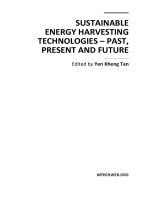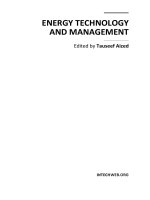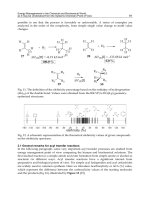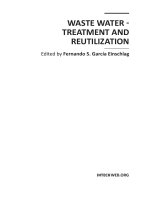- Trang chủ >>
- Khoa Học Tự Nhiên >>
- Vật lý
Green Energy Technology, Economics and Policy Part 1 potx
Bạn đang xem bản rút gọn của tài liệu. Xem và tải ngay bản đầy đủ của tài liệu tại đây (322.13 KB, 28 trang )
Green Energy
Technology, Economics and Policy
Green Energy
Technology,Economics and Policy
Editors
U. Aswathanarayana, General Editor
Mahadevan International Centre for Water Resources Management,
Hyderabad, India
T. Harikrishnan, Section 3
IAEA, Vienna, Austria
K.M. Thayyib Sahini, Section 6
IAEA, Vienna, Austria
CRC Press/Balkema is an imprint of the Taylor & Francis Group,
an informa business
© 2010 Taylor & Francis Group, London, UK
Typeset by MPS Ltd (A Macmillan Company) Chennai, India
Printed and bound in Great Britain by TJ International Ltd,
Padstow, Cornwall
All rights reserved. No part of this publication or the information
contained herein may be reproduced, stored in a retrieval system,
or transmitted in any form or by any means, electronic, mechanical,
by photocopying, recording or otherwise, without written prior
permission from the publishers.
Although all care is taken to ensure integrity and the quality of this
publication and the information herein, no responsibility is
assumed by the publishers nor the author for any damage to the
property or persons as a result of operation or use of this
publication and/or the information contained herein.
British Library Cataloguing in Publication Data
A catalogue record for this book is available from the British Library
Library of Congress Cataloging-in-Publication Data
Green energy : technology, economics, and policy / U. Aswathanarayana,
T. Harikrishnan, K.M. Thayyib Sahini.
p. cm.
Includes bibliographical references and index.
ISBN 978-0-415-87628-5 (hard back : alk. paper) — ISBN 978-0-203-84146-4 (e-book)
1. Renewable energy sources. 2. Renewable energy sources — Costs. I. Aswathanarayana, U.
II. Harikrishnan,T. (Tulsidas) III. Thayyib Sahini, K. M. (Kadher Mohien) IV. Title.
TJ808.G693 2010
333.79’ — dc22 2010022877
Published by: CRC Press/Balkema
P.O. Box 447, 2300 AK Leiden,The Netherlands
e-mail:
www.crcpress.com – www.taylorandfrancis.co.uk – www.balkema.nl
ISBN: 978-0-415-87628-5 (Hbk)
ISBN: 978-0-203-84146-4 (eBook)
Dedicated to my Late Father, Sudarsanarao.
Contents
List of Figures xv
List of Tables xvii
Preface xxi
Foreword xxiii
List of Contributors xxv
Units, Abbreviations and Acronyms, Definitions
and Conversion Constants xxvii
Section 1: Introduction (U. Aswathanarayana) 1
Section 2: Renewable energy technologies (U. Aswathanarayana) 5
Chapter 1 Renewables and climate change (U. Aswathanarayana) 7
1.1 Projected growth of renewables 7
Chapter 2 Wind power (U. Aswathanarayana) 11
2.1 Introduction 11
2.2 Environmental factors 12
2.3 Costs 13
2.4 Wind power markets 13
2.5 Projected growth of wind power 15
2.6 Offshore wind power 15
2.7 Prognosis 20
Chapter 3 Solar energy (U. Aswathanarayana) 21
3.1 Introduction 21
3.2 PV technology 22
3.3 Thin films 23
viii Contents
3.4 Costs 24
3.5 Research & Development needed 24
3.6 New concept PV devices 26
3.7 Concentrated Solar Power 26
Chapter 4 Biomass (U. Aswathanarayana) 29
4.1 Introduction 29
4.2 Technology 29
4.3 Algal biofuels 32
4.4 Biomass wastes 34
4.5 Costs 35
4.6 Ethanol 36
4.7 Landfill Gas 36
4.8 Prognosis 38
Chapter 5 Hydropower (U. Aswathanarayana) 39
5.1 Introduction 39
5.2 “Storage’’ Projects 40
5.3 Pumped storage hydroelectricity 42
5.4 “In-river’’ hydroelectric projects 43
Chapter 6 Geothermal energy (U. Aswathanarayana) 45
6.1 Introduction 45
6.2 Technology 46
6.3 Resources 46
6.4 Costs 47
6.5 Research & Development 48
Chapter 7 Tidal power (U. Aswathanarayana) 49
7.1 Introduction 49
7.2 Resource position 50
7.3 Rance (France) and Severn (UK) tidal barrages 50
7.4 Research & Development and Costs 51
Chapter 8 Deployment of renewable energy technologies
(U. Aswathanarayana) 53
8.1 Characteristics and costs of common RETs 53
8.2 Potentials of RETs 53
8.3 Measuring policy effectiveness and efficiency 58
8.4 Overview of support schemes 59
8.5 Public–private partnership 60
8.6 An Integrated Strategy for the deployment of RETs 62
8.7 Renewable energy development in China and India 63
References 63
Section 3: Supply-side energy technologies (T. Harikrishnan, IAEA) 65
Chapter 9 Fossil fuels and CCS (T. Ohsumi) 67
9.1 Introduction 67
9.2 Efficiency improvement in power generation 70
Contents ix
9.3 Fuel switching in fossil fuel power plants 71
9.4 Capture of CO
2
73
9.5 Compression of CO
2
75
9.6 Transport of CO
2
in CCS 76
9.7 Storage of CO
2
78
Chapter 10 Nuclear power (T. Harikrishnan) 81
10.1 Introduction 81
10.1.1 Future projections 81
10.1.2 Nuclear power and green energies 83
10.2 Nuclear fission 84
10.2.1 Fission chain reaction 84
10.2.2 Natural fission reactors 85
10.2.3 Nuclear reactors 86
10.3 Sustainable nuclear fuel cycle options 90
10.3.1 Thorium fuel cycle 91
10.3.2 Uranium resources and production 92
10.3.3 Thorium resources 95
10.3.4 Uranium conversion, enrichment and
fuel fabrication 96
10.3.5 Spent fuel management and reprocessing 97
10.4 Advanced and next generation reactors 98
10.4.1 Generation IV reactors 98
10.4.2 Generation V reactors 99
10.4.3 Fusion reactors 99
10.4.4 Accelerator Driven System 100
10.5 Nuclear economics 100
10.6 Nuclear safety 102
10.7 Disposal of nuclear wastes 105
Chapter 11 Next generation green technologies (T. Harikrishnan) 109
11.1 Introduction 109
11.2 Biomass gasification 110
11.2.1 Biomass 111
11.2.2 Gasification 112
11.2.3 Syngas 114
11.2.4 Fischer–Tropsch process 115
11.2.5 Biomass Integrated-gasifier/gas
turbine combined cycle 116
11.2.6 Environmental benefits of gasification 117
11.3 Marine energy 117
11.3.1 Marine current power 118
11.3.2 Ocean thermal energy 120
11.3.3 Salinity gradient power 123
11.3.4 Tidal power 124
11.3.5 Wave power 126
11.3.6 Damless hydro 130
x Contents
11.4 Enhanced Geothermal Systems 131
11.4.1 Technical considerations 132
11.4.2 Economic considerations 135
11.4.3 Further studies required 136
11.4.4 Induced seismicity 136
Chapter 12 Algal biofuels (Sabil Francis) 137
12.1 Introduction 137
12.2 Comparative advantages 138
12.3 Problems with algal biofuels 139
12.4 Technologies 140
12.4.1 Cultivation of algae 140
12.4.2 Harvesting of algae 141
12.4.3 Extraction of various energy products
from algae 141
References 144
Section 4: Demand-side energy technologies (U. Aswathanarayana) 149
Chapter 13 Industry (U. Aswathanarayana) 151
13.1 Industrial energy use and CO
2
emissions profile 151
13.2 Iron and steel 154
13.3 Non-metallic minerals 157
13.4 Chemicals and petrochemicals 159
13.5 Pulp and Paper 162
13.6 Non-ferrous metals 164
13.7 Research & Development, Demonstration and
Deployment 165
Chapter 14 Buildings & Appliances (U. Aswathanarayana) 169
14.1 Introduction 169
14.1.1 The building shell, heating and cooling 172
14.1.2 Windows 173
14.1.3 Hot water 174
14.1.4 Cooling systems: air conditioning 174
14.1.5 Appliances 175
14.1.6 Lighting 175
14.1.7 Heat pumps 176
14.1.8 Solar thermal heating 178
14.2 Passive houses and zero-energy buildings 179
14.3 Bioenergy technologies 180
14.4 Research & Development, Demonstration and
Deployment 182
Chapter 15 Transport (U. Aswathanarayana) 183
15.1 Overview 183
15.2 Alternative fuels 185
15.2.1 Biofuels for transport 186
15.2.2 Electricity in transport 187
15.2.3 Hydrogen in transport 187
Contents xi
15.3 Light-duty vehicles 188
15.4 Trucking and freight movement 193
15.5 Aviation 195
15.6 Maritime transport 197
15.7 Research & Development breaktroughs required for
technologies in transport 199
Chapter 16 Electricity systems (U. Aswathanarayana) 201
16.1 Overview 201
16.2 Transmission Technologies 202
16.3 Distribution 203
16.4 Electricity Storage Systems 204
16.5 Demand Response 206
16.6 “Smart’’ Grid application 207
16.6.1 Electricity Pricing 209
16.6.2 Electricity grid and peak demand response 210
16.6.3 Incentives to shed loads 211
16.6.4 Technologies for demand reduction. 211
16.6.5 “Power Plant in a box’’ 212
References 212
Section 5: Making green energy competitive (U. Aswathanarayana) 215
Chapter 17 Roadmaps and phases of development of low-carbon
technologies (U. Aswathanarayana) 217
17.1 Why low-carbon energy technologies? 217
17.2 Emission reductions and Research Development &
Demonstration investment 219
17.3 Innovation Systems in Technology Development 220
17.4 Research, development and Demonstration in the
energy sector 223
17.4.1 Renewable Energy Sector 224
17.4.2 Fossil Fuel Power 224
17.4.3 Electricity System 225
17.4.4 Industry – Process Innovations 225
17.4.5 Buildings and Appliances 225
17.4.6 Transport – Vehicles 225
17.4.7 Transport – Fuels 225
17.4.8 Cross-cutting 226
17.5 Research, development and Demonstration
policies 226
Chapter 18 Deployment and role of technology learning
(U. Aswathanarayana) 229
18.1 Introduction 229
18.2 Technology Learning Curves 230
18.3 Commercialization of power generation
technologies 232
18.4 Deployment costs 233
xii Contents
18.5 Regional deployment of key power generation
technologies 234
18.6 Barriers to technology diffusion 235
18.7 Strategy for accelerating deployment 236
18.8 Investment issues 236
Chapter 19 Energy efficiency and energy taxation (U. Aswathanarayana) 239
19.1 Matrix of Economic Evaluation Measures 239
19.2 Total Life-Cycle Cost (TLCC) 241
19.3 Levelized Cost of Energy (LCOE) 242
19.4 Energy Efficiency of Renewable Energy Systems 244
19.5 Energy taxation 250
19.6 Renewable Energy Tax Credits 251
19.7 Depreciation 251
Chapter 20 Energy economics and markets (U. Aswathanarayana) 255
20.1 Introduction 255
20.2 Modeling electricity markets 257
20.3 Average costs and marginal costs 258
20.4 Load cycle 259
20.5 Energy economics 260
20.6 Levelized costs 261
20.7 Limit pricing model 262
20.8 Pollution as a negative externality 263
20.9 Energy futures and options markets 265
20.10 Energy and Information technology 266
Chapter 21 Renewable energy policies (U. Aswathanarayana) 269
21.1 Why renewables? 269
21.2 Market-based strategies to promote green energies 272
21.3 Country case histories 274
21.3.1 The Dutch Green Electricity programme 274
21.3.2 The USA Green Electricity Market 275
21.3.3 U.K. Green Electricity Market 277
21.4 Lessons 278
References 278
Section 6: A green new deal (K.M. Thayyib Sahini) 281
Chapter 22 Goals of the green new deal (K.M. Thayyib
Sahini, IAEA) 283
22.1 Introduction 283
22.2 Smart electricity grid 283
22.3 Decarbonising electricity production 286
22.4 Decarbonising transport 289
22.5 Decarbonising buildings 290
22.6 Decarbonising industry 291
22.7 Conclusion 292
Contents xiii
Chapter 23 Ways of “greening the economy’’
(Jayaraj Manepalli, Vienna) 293
23.1 Introduction 293
23.1.1 The challenges in the energy sector 293
23.1.2 The Urgency 294
23.1.3 Green Energy 294
23.2 Greening the economy: the challenge 295
23.2.1 Carbon Credits: Are these measures enough? 296
23.3 Financial stimuli 297
23.4 Research and development 299
23.5 Infrastructure development 301
23.6 Employment generation 302
23.7 Social security 304
23.8 Education and outreach 305
23.9 Conclusion 306
Chapter 24 Poverty, environment and climate change
(K.M. Thayyib Sahini, IAEA) 309
24.1 Introduction 309
24.2 Climate change challenge and poverty 310
24.3 Poverty and environment 311
24.4 Eradicating poverty 313
24.5 Energy for Development 314
24.6 Integrating poverty eradication, environment
protection and energy security 315
24.7 Conclusion 317
References 318
Section 7: Overview and integration (U. Aswathanarayana) 323
Author index 333
Subject index 337
xvi List of Figures
Figure 9.8 An example of shuttle tanker operation from a capture
plant on-shore to an injection well offshore 77
Figure 10.1 A nuclear fission chain reaction 85
Figure 10.2 Oklo natural fission reactors 86
Figure 10.3 Ranges of levelized costs associated with new nuclear
reactor construction 101
Figure 10.4 Unplanned scrams per 7 000 hours critical 104
Figure 10.5 Industrial accidents at nuclear power plants per 1 000 000
person-hours worked 104
Figure 10.6 Evolution of the total annual collective dose (man Sv)
and number of operating reactors 105
Figure 10.7 World average radiation exposure for a person 106
Figure 11.2.1 Open top twin air entry re-burn gasifier 114
Figure 11.3.1 Scheme of closed cycle OTEC plant 121
Figure 11.3.2 Approximate global distribution of wave power levels
(kW/m of wave fuel) 127
Figure 11.4.1 Two-well Enhanced Geothermal System 134
Figure 12.1 Paths to the various energy products from algae 138
Figure 12.2 Working of a photo-bioreactor 140
Figure 12.3 Detailed process of biodiesel from algae 142
Figure 12.4 Extraction of ethanol using algae 143
Figure 12.5 Hydrogen from algae 144
Figure 13.1 CO
2
emissions per tonne of steel produced 155
Figure 13.2 Energy efficiency of various cement clinker production
technologies 158
Figure 14.1 System efficacy of various light sources 177
Figure 15.1 Fuel efficiency improvements of different power trains 189
Figure 15.2 Energy densities of batteries and liquid fuels 190
Figure 15.3 Fuel cell concept 192
Figure 15.4 Projected GHG reduction of light duty vehicles and fuels 194
Figure 16.1 Capital cost of different storage options 205
Figure 16.2 Discharge times and system ratings of different storage options 205
Figure 16.3 General layout of electricity networks 208
Figure 16.4 Arrangement of grid 209
Figure 16.5 Relationship between quantity and power 209
Figure 17.1 Schematic working of the innovation chain 221
Figure 17.2 Relationship between government expenditure and
the number of researchers 222
Figure 17.3 CO
2
saving achieved by technology clusters 223
Figure 18.1 Learning curves, deployment costs and learning investments 231
Figure 19.1 Lifetime of the investment and LCOE 243
Figure 19.2 Solar fraction optimization 245
Figure 19.3 Retrofit scenarios 249
Figure 20.1 Limit pricing model 263
Figure 20.2 Costs and benefits of pollution 264
xviii List of Tables
Table 10.2 Current nuclear power reactor types 88
Table 10.3 Current world nuclear reactors 89
Table 10.4 Nuclear fuel cycle stages and activities 90
Table 10.5 Thorium utilization in different experimental and power reactors 93
Table 10.6 Total identified uranium resources 94
Table 10.7 World uranium production 95
Table 10.8 World resources of thorium 96
Table 11.2.1 Gasification processes 112
Table 11.2.2 Advantages and disadvantages of different types of gasifiers 114
Table 11.3.1 Marine renewable resources 118
Table 11.3.2 Operating and proposed tidal power facilities 125
Table 11.3.3 Prototype tidal stream generators 126
Table 11.3.4 Some examples of wave power systems 129
Table 11.4.1 Current EGS projects 134
Table 12.1 Summary of processes for converting algae to energy 138
Table 12.2 Flue gas composition from coal fired power plant that
could be used for algae cultivation and biofuel generation 139
Table 12.3 Fuel yield per acre of production per year 139
Table 12.4 Comparative advantages and disadvantages of
photo-bioreactor cultivation 141
Table 13.1 Energy and CO
2
emissions of key industries 151
Table 13.2 Industrial CO
2
reductions by sector in the ACT and
BLUE Map scenarios 152
Table 13.3 Industrial direct energy and process CO
2
emissions in
world regions (2005 Mt CO
2
/yr) 153
Table 13.4 Final energy use by energy carrier and direct CO
2
emissions
related to energy use, 2005 154
Table 13.5 Global technology prospects for direct casting 156
Table 13.6 Global technology prospects for CCS for cement kilns 159
Table 13.7 Global technology prospects for biomass feedstocks
and biopolymers 161
Table 13.8 Global technology prospects for membranes 162
Table 13.9 Global technology prospects for black liquor gasification 163
Table 13.10 Global technology prospects for energy-efficient
drying technologies 164
Table 13.11 Best Available Technology (BAT) for the paper
and pulp industry 164
Table 13.12 Global technology prospects for inert anodes and
bipolar cell design in primary aluminium production 165
Table 13.13 RD&D breakthroughs needed 166
Table 14.1 Final Energy consumption in the services and residential
sectors in different regions in 2005 171
Table 14.2 Reduction below the baseline scenarios in 2050 by scenario 173
Table 14.3 Comparison of BAT for cold appliances and energy
efficiency options in the European Union, India and China 176
Table 14.4 Biomass conversion technologies 181
Table 14.5 RD&D targets 182
List of Tables xix
Table 14.6 RD&D breakthroughs needed 182
Table 15.1 Targets for the transport sector 186
Table 15.2 Costs of plug-in hybrids in terms of driving range 191
Table 15.3 Performance and use of different fuel cells 192
Table 15.4 Technology breakthroughs in the transport sector 199
Table 16.1 Transmission and distribution losses 202
Table 16.2 Cost performance of transmission systems 203
Table 16.3 Cost comparisons of base-load supply systems 206
Table 17.1 Emission of greenhouse gases by some important countries 218
Table 17.2 Top five countries for energy-related CO
2
emissions in
the reference scenario 218
Table 17.3 Key technologies on the supply-side and demand-side 219
Table 17.4 Emission reduction and RD&D investment 220
Table 18.1 Gives the observed training rates for various electricity supply
technologies 232
Table 18.2 Applied learning rates for power generation technologies 233
Table 18.3 Applied learning rates for building, industry and
transport technologies 233
Table 18.4 Regional deployment of power generation technologies 234
Table 19.1 Overview of economic measures related to investment decision 240
Table 20.1 Per capita GDP, energy use and CO
2
emissions 256
Table 20.2 World net electricity generation (in Billion kWh) by type, 2000 257
Table 20.3 Net electricity generation (in trillion kWh) in the world,
by energy resources, 2006–2030 257
Table 20.4 Comparative electricity generating costs (2001 US cents/kWh)
including capital 262
Table 21.1 Renewable technology summary 271
Table 21.2 New renewable capacities built and planned in the USA 276
xxii Preface
economical and policy interventions needed to make the Renewable Energy
Technologies (RETs) competitive in the market are covered in Section 5. Section 6
gives a vision of a Green New Deal integrating the technological, socioeconomic and
policy strands. The final section 7 provides an overview and Integration.
I thank Dr. R.A. Mashelkar, President, Global Research Alliance, for his percep-
tive Foreword. Drs. Makarand Phadke of RIL and R. Dhanraj (formerly of AMD)
kindly reviewed the manuscript, and made suggestions for improvement. The volume is
meant for university students, professionals and administrators in the areas of resource
engineering, energy industries, environmental science and engineering, climate change,
economics, etc.
Hyderabad, India U. Aswathanarayana
June, 2010
xxiv Foreword
the world population is growing and poor countries are becoming richer, we require
fundamental changes in the way we produce and use energy. We require changes in the
way we manage forests, land use, and agriculture. Greater energy efficiency, manage-
ment of energy demand, and diffusion of low-carbon electricity sources such as wind,
hydro, and nuclear could produce half of the required emission cuts.
The solutions that can potentially lead to ‘carbon neutrality’ are currently expen-
sive. To satisfy future global energy demand will require improving the performance
of low-carbon technologies and developing breakthrough technologies through not
‘incremental’ but ‘disruptive’ innovations. Our current hope rests on potential success
in carbon capture and storage, second-generation biofuels, and solar photovoltaics.
The fact that a particular source of energy exists does not mean that it automatically
becomes techno-economically or a socially acceptable option. Thus in the case of wind
energy, despite the advances in technology, the costs need to be still brought down.
Protests are heard from conscious society so social acceptability remains a challenge.
The book provides an interesting analysis of the factors that will make green energy
competitive. For instance, it is brought out that the role of technology is as impor-
tant as innovative energy taxation policies. The book examines both supply side and
demand side energy technologies. There is a very thoughtful discussion on nuclear
power economics.
This book is a ‘must read’ for students (both in education and research) and pro-
fessionals (both producers and managers of sustainable energy solutions) and policy
planners (dealing with energy, environment and economics).
Provision of energy supply with the characteristics of cleanliness, reliability, security
and competitiveness is a challenge facing the 21st century world. This book is a valuable
resource, which guides us towards an analysis of critical factors that will help us
in achieving this path. I offer my congratulations to the authors for this timely and
valuable contribution.
Pune, India R.A. Mashelkar
June, 2010 Bhatnagar Fellow &
President, Global Research Alliance
xxvi List of Contributors
Albert Schweitzer Haus,
Garnisongasse 14-16/604
A1090, Vienna
Austria
Email:
Sabil Francis (author C.12)
Research Academy Leipzig
Graduate Centre Humanities and Social Sciences
University of Leipzig
GC Humanities
Emil-Fuchs-Str. 1
04105 Leipzig
Germany
Email:
Prof. U. Aswathanarayana
Honorary Director, Mahadevan International Centre
for Water Resources Management
B-16 Shanti Shikhara Apts.
Somajiguda, Hyderabad - 500 082
India
Email:
xxviii Units, Abbreviations and Acronyms, Definitions, Conversion Constants
MW
e
megawatt electrical
MWh megawatt hour
PJ petajoule = 10
15
joules
EJ Exajoule = 10
18
joules
ZJ Zettajoule = 10
21
joules
toe tonne of oil equivalent
TW terawatt = 10
12
watts
TWh terawatt hour
Wp watt-peak
Abbreviations and Acronyms
(source: IEA’s Energy Technology Perspectives, 2008. p. 602–613)
AFC Alkaline Fuel Cell
API American Petroleum Institute
APU Auxiliary Power Unit
ASU Air Separation Unit
ATR Auto Thermal Reforming
B2B Business-to-Business
B2C Business-to-Consumer
B2G Business-to-Government
BEMS Building Energy Management System
BFB Bubbling Fluidised Bed
BIGCC Biomass Integrated Gasification with Combined Cycle
BtL Biomass to Liquids
CAES Compressed Air Energy Storage System
CAT Carbon Abatement Technologies
CBM Coal-Bed Methane
CCS CO
2
Capture and Storage
CDM Clean Development Mechanism
CdTe Cadmium Telluride
CFB Circulating Fluidised Beds
CFL Compact Fluorescent Light-bulb
CHP Combined Heat and Power
CIS Copper-Indium-Diselenide
CIGS Gallium-doped Copper – Indium–Diselenide
CNG Compressed Natural Gas
CSP Concentrating Solar Power
CTL Coal To Liquids
DME Dimethyl Ether
EGR Enhanced Gas Recovery
EIA Environment Impact Assessment
FBC Fluidised Bed Combustion
FDI Foreign Direct Investment
FGD Flue Gas Desulphurisation
HTGR High Temperature Gas Cooled Reactor
Units, Abbreviations and Acronyms, Definitions, Conversion Constants xxix
IAEA International Atomic Energy Agency
IEA International Energy Agency
IET International Emissions Trading
IGCC Integrated Gasification Combined Cycle
IGFC Integrated Gasification Fuel cell combined Cycle
ITER International Thermonuclear Experimental Reactor
LED Light Emitting Diode
LNG Liquified Natural Gas
LPG Liquid Petroleum Gases
NEA Nuclear Energy Agency
NGL Natural Gas Liquids
NSG Nuclear Suppliers Group
O&M Operating and Maintenance
OECD Organisation for Economic Cooperation and Development
OPEC Organization of Petroleum Exporting Countries
PFBC Pressurised Fluidised Bed Combustion
PM-10 Particulate matter of less than ten microns in diameter
PPP Purchasing Power Parity
P&T Partitioning and Transmutation
PV Photovoltaics
PWR Pressurised water Reactor
RDD&D Research, development, demonstration and deployment
RETs Renewable Energy Technologies
SACS Saline Aquifer CO
2
Storage
SCSC Supercritical Steam Cycle
SMR Small and Medium-sized Reactor
T&D Transmission and Distribution
USCSC Ultra Super Critical Steam Cycle
VHTR Very High Temperature Reactor
Definitions
Source A: Energy Technology Perspectives, 2008, p. 601–605
Source B: International Energy Markets. 2004. Carol A. Dahl, Pennwell Corporation,
p. 475–533.
Ad valorem tax: A tax that is a percentage of the price of a good or a service (B)
Amortization: Allocating the cost of intangible assets over their legal life as specified
in the tax code (B).
API Gravity: Specific gravity measured in degrees on the American Petroleum Institute
scale. The higher the number, the lower the density. Twentyfive degrees API equals
0.904 kg/m
3
. Forty-two degrees API equals 0.815 kg/m
3
. (A)
Avoided cost: The amount avoided for the incremental purchase or the production of
a good (B).
Benefits of Pollution: Any costs that you forego by being able to pollute rather than to
abate. Benefits of pollution are then equal to the costs of abatement. (B)
xxx Units, Abbreviations and Acronyms, Definitions, Conversion Constants
Biodiesel: Biodiesel is a diesel-equivalent, processed fuel made from the transesterifi-
cation (a chemical process which removes the glycerine from the oil) of vegetable
oils or animal fats. (A)
Biogas: A mixture of methane and carbon dioxide produced by bacterial degradation
of organic matter and used as fuel. (A)
Blackouts: A non-isolated power loss over an extended period of time due to capacity
shortage. It may result from peak loads higher than available capacity or from
equipment failure (B).
Black liquor: A by-product from chemical pulping processes which consists of
lignin residue combined with water and the chemicals used for the extraction of
lignin. (A)
Breakeven Pricing: Charging a price for which revenues exactly equal all costs including
opportunity costs. (B)
Brent Forward Market: The over-the-counter market for buying Brent Crude oil at
some future date. (B)
Clean Coal Technologies (CCT): Technologies designed to enhance the efficiency and
the environmental acceptability of coal extraction, separation and use. (A)
Clearinghouse: An institution that is a part of an organized exchange that guarantees
each transaction and matches buyers to sellers when contracts come due. (B)
Coal: Lignite (with gross calorific value of less than 4165 kcal/kg), sub-bituminous coal
(4165–5700 kcal/kg) and hard coal (greater than 5700 kcal/kg, on an ash-free but
moist basis). Clean Coal Technologies (CCTs) are designed to enhance the efficiency
and the environmental acceptability of coal extraction, preparation and use. Coal-
bed methane is methane found in coal seams, and is a source of unconventional
natural gas (A).
Coases Theorem on Externalities: In the absence of transaction costs and market power,
that private markets will arrive at an optimal allocation in the presence of market
externalities no matter how property rights are originally distributed. (B)
Condensates: Condensates are liquid hydrocarbon mixtures recovered from non-
associated gas reservoirs. They are composed of C4 and higher carbon number
hydrocarbons and normally have an API between 50
◦
and 85
◦
. (A)
Cross Price Elasticity: The percentage change in quantity of one good that results from
the percentage change in price of another good. (B)
Data Mining: Techniques for extracting information from large databases. (B)
Deregulation: Removing government regulations. (B)
Discounted Cash Flow (DCF): The present value of future flows of income. (B)
Discount Rate: The interest rate for converting or discounting future cash values to
present values. (B)
Electricity Generation: Total amount of electricity generated by power plants. It
includes its own use, and transmission and distribution losses. (A)
Energy Futures: A standardized contract offered and guaranteed on an organized
exchange to buy or sell an energy product in the future. (B)
Enhanced Coal-bed Methane Recovery (ECBM): A technology for the recovery of
methane through CO
2
injection into uneconomic coal seams. (A)
Enhanced Gas Recovery (EGR): A speculative technology in which CO
2
is injected
into a gas reservoir in order to increase the pressure in the reservoir, so that more
gas can be extracted. (A)
Units, Abbreviations and Acronyms, Definitions, Conversion Constants xxxi
Ethanol: Ethanol is an alcohol made by fermenting any biomass high in carbohydrates
(such as, starches and sugars). Emerging technologies will allow ethanol to be
produced from cellulose and hemicellulose fibres that make up the bulk of the most
plants. (A)
Financial Derivatives: Financial assets that derive their value from an underlying asset
upon which they are based. (B)
Gas: Gas includes natural gas (both associated and non-associated with petroleum
deposits but excluding natural gas liquids) and gas-works gas. (A)
Gas-to-Liquids: Fischer-Tropsch technology is used to convert natural gas into syn-
thetic gas (syngas) and then, through catalytic reforming or synthesis, into very
clean conventional oil products, such as diesel. (A)
Hydrocracking: Refinery process that heats heavy oil products under pressure in the
presence of hydrogen to remove sulphur and increase lighter product yields. (B)
Hydropower: Hydropower refers to the energy content of the electricity produced in
hydropower plants, assuming 100% efficiency. It excludes output from pumped
storage plants. (A)
Marginal Production Cost: The cost of the last unit of production. (B)
Marketable Permits: Permits to pollute that can be bought and sold in the market
place (B).
Metcalfe’s Law: A network’s value increases as the square of the number of connec-
tions (B).
Multivariate Time Series: A statistical forecasting technique in which a variable is
forecast by using historical values of itself and other related variables (B).
Natural Gas Liquids (NGLs): They are the liquid or liquefied hydrocarbons produced
in the manufacture, purification and stabilization of natural gas. These are those
portions of natural gas which are recovered as liquids in separators, field facilities,
or gas-forming plants. NGLs include but not limited to ethane, propane, butane,
pentane, natural gasoline and condensates. (A)
Negative Externalities: An externality is an effect from an economic activity that
involves some one not directly involved in the economic activity. (B)
Nuclear: Nuclear refers to the primary heat-equivalent of the electricity produced by
a nuclear plant with an average thermal efficiency of 33%. (A)
Oil: Oil includes crude oil, condensates, natural gas liquids, refinery feedstocks, and
additives and other hydrocarbons (including emulsified oils, synthetic crude oil,
mineral oils extracted from bituminous minerals such as oil shale, bituminous
sand, and oils from coal liquefaction) and petroleum products (refinery gas, ethane,
LPG, aviation gasoline, motor gasoline, jet fuels, kerosene, gas/diesel oil, heavy
fuel oil, naphtha, white spirit, lubricants, bitumen, paraffin waxes and petroleum
coke). (A)
Opportunity Cost: What you forego by undertaking an economic activity. (B)
Outage: A temporary loss of power from isolated electricity transmission, generation
or distribution failure. (B)
Peak load pricing: Charging higher prices during peak hours than off-peak hours. (B)
Pollution tax: A payment of tax to the government for the right to pollute. (B)
Power Generation: refers to fuel use in electricity plants, heat plants, and combined
heat and power (CHP) plants. Both main activity producer plants and small plants
that produce fuel for their own use (autoproducers) are included. (A)
xxxii Units, Abbreviations and Acronyms, Definitions, Conversion Constants
Price Elasticity of Demand: Percentage change in the quantity demanded of a good
divided by the percentage change in its own price (B).
Public good: A good that no one is excluded from using. (B)
Purchasing Power Parity (PPP): The rate of currency conversion that equalizes the
purchasing power of different currencies, by making allowances for the differences
in price levels and spending patterns between different countries. (A)
Research, development and Demonstration (RD&D)
Renewables: includes biomass and waste, geothermal, solar PV, solar thermal, wind,
tide, and wave energy for electricity and heat generation. (A).
Straight-line Depreciation: Using an annual depreciation charge for tax purposes equal
to the value of the asset divided by its allowed depreciable life. (B)
Strike Price: The price at which a put or a call entitles you to sell or buy the underlying
asset (B).
Total Final Consumption (TFC): It is the sum of the consumption by the different
end-use sectors: industry (including manufacturing and mining), transport, other
(including residential, commercial and public services, agriculture/forestry and
fishing), non-energy use (including petrochemical feedstocks), and non-specified.
(A)
Total Primary Energy Demand: Total Primary Energy Demand represents domestic
demand only, including power generation, other energy sector, and total final
consumption. It excludes international marine bunkers, except for world energy
demand where it is included. (A)
Conversion Constants
Source: “World Energy Outlook 2007’’, International Energy Agency, Paris, 2007,
p. 633–641.
General Conversion factors for Energy
To TJ Gcal Mtoe MBtu GWh
From Multiply by
TJ 1 238.8 2.388 × 10
−5
947.8 0.2778
Gcal 4.1868 × 10
−3
110
−7
3.968 1.163× 10
−3
Mtoe 4.1868 × 10
4
10
7
1 3.968 × 10
7
11 630
MBtu 1.0551 × 10
−3
0.252 2.52 × 10
−8
1 2.931 × 10
−4
GWh 3.6 860 8.6× 10
−5
3.412 1
TJ = Tera Joules; Gcal = Gigacalories ; Mtoe = Million tonnes of oil equivalent
MBtu = Million British Thermal Units; GWh = Gigawatt hours
1 million tonnes of oil equivalent = 1.9814 million tonnes of coal
= 0.0209 million barrels of oil/day
= 1.2117 billion cubic metres of gas
Units, Abbreviations and Acronyms, Definitions, Conversion Constants xxxiii
Conversion factors for mass
To kg t lt st lb
From: multiply by
kilogramme (kg) 1 0.001 9.84 × 10
−4
1.102 × 10
−3
2.2046
tonne (t) 1 000 1 0.984 1.1023 2 204.6
long ton (lt) 1 016 1.016 1 1.120 2 240.0
short ton (st) 907.2 0.9072 0.893 1 2 000.0
pound (lb) 0.454 4.54 × 10
−4
4.46 × 10
−4
5.0 × 10
−4
1
Conversion factors for volume
To gal U.S. gal U.K. bbl ft
3
Lm
3
From: multiply by
U.S. gallon (gal) 1 0.8327 0.02381 0.1337 3.785 0.0038
U.K. gallon (gal) 1.201 1 0.02859 0.1605 4.546 0.0045
Barrel (bbl) 42.0 34.97 1 5.615 159.0 0.159
Cubic foot (ft
3
) 7.48 6.229 0.1781 1 28.3 0.0283
Litre (L) 0.2642 0.220 0.0063 0.0353 1 0.001
Cubic metre (m
3
) 264.2 220.0 6.289 35.3147 1 000.0 1
2 Green Energy Technology, Economics and Policy
the countries to decide upon the actual mix of RETs, and timing of the policy incentives,
depending upon the local biophysical and socioeconomic situations. All RETs are
evolving rapidly in response to technology improvements and market penetration. The
deployment of RETs has two concurrent goals : (i) exploit the “low-hanging’’ fruit of
abundant of RETs which are closest to market competitiveness, and (ii) developing
cost-effective ways for a low-carbon future.
Renewable fuels, such as wind, solar, biomass, tides, and geothermal, are inex-
haustible, indigenous and are often free as a resource. They just need to be captured
efficiently and transformed into electricity, hydrogen or clean transportation fuels. In
effect, the development of renewal energy invests in people, by substituting labour
for fuel. The renewables have hardly any carbon footprint, and do not require
environmentally-damaging mining and transport. For these reasons, “green’’ energy
should be considered as the energy of the future. That said, the most important
challenge facing the renewables is to bring down their costs.
Though the Copenhagen Accord did reiterate adherence to the goal of limiting global
temperature rise to 2
◦
C by 2050, the assessment of UNFCCC is that because of the
inadequacy of the mitigation efforts, the temperature rise is likely to be 3
◦
C by 2050.
This is a serious matter. M.S. Swaminathan drew attention to the implications for India
ofa1
◦
C rise in global temperature. There would be an annual loss of about 6 million
tonnes of wheat production, worth USD 1.5 billion, and gross loss of about USD 20
billion to the farmers.
The volume is addressed to the delineation of the ways and means of using technol-
ogy, economics and policy to provide clean, reliable, secure and competitive energy
supply. China and to a lesser extent India, have shown how exactly this could be done.
China has emerged as the largest maker of wind turbines and the largest manufac-
turer of solar panels in the world. It is building the most efficient types of coal power
plants. China today has 9 GW of nuclear power. It is preparing to build three times
more nuclear power plants in the coming decade as the rest of the world put together.
Renewable energy industries have created 1.12 million new jobs in 2008. China’s top
leadership is intensely focused on energy policy – it created a National Energy Commis-
sion which is a kind of “superministry’’ headed by Prime Minister Wen Jiabao himself.
New York Times makes a prescient observation that just as the West has been depen-
dent on Middle East for oil, it is destined to be dependent on China for renewable
energy technologies.
The purpose of the book is to elucidate Green New Deal models, whereby the twin
objectives of job generation as a way of promoting economic development, and mitiga-
tion of climate change impacts through low-carbon technologies, are achieved through
the harnessing of the transformative power of technology. Energy science and technol-
ogy are sought to be linked with energy economics and markets and energy policy
and planning. This is sought to be accomplished through public – private partner-
ship in the prosecution of Innovation Chain (Basic Research → Applied Research &
Development → Demonstration → Deployment → Commercialization).
Denmark shows the way for developing a low-carbon economy through innovative
application of energy technologies. Denmark gets bulk of its electricity from coal.
During the last twenty years, the greenhouse gas emissions were reduced by 14%.
While the energy consumption remained unchanged, GDP went up by 40%. Denmark
is the most energy efficient country in Europe. Energy tax revenues are ploughed back









